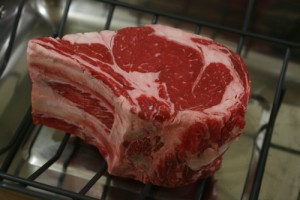After a few days at the beach and being disappointed with restaurant food, it was good to be home, with my BBQ and a rib roast.
It was fairly delicious.
 But the question arises, was it needle tenderized, potentially passing pathogens from the exterior to the interior and requiring a higher cooking temperature for safety.
But the question arises, was it needle tenderized, potentially passing pathogens from the exterior to the interior and requiring a higher cooking temperature for safety.
I know the butcher where I purchased the meat, he knows what I do, and they cut the carcass up at the shop, so I believe him when he says it wasn’t needle tenderized.
All food purchases are faith-based.
Boneless beef rib eye roasts were surface inoculated on the fat side with ca. 5.7 log CFU/g of a five-strain cocktail of Salmonella for subsequent searing, cooking, and warm holding using preparation methods practiced by restaurants surveyed in a medium-size Midwestern city.
A portion of the inoculated roasts was then passed once through a mechanical blade tenderizer. For both intact and nonintact roasts, searing for 15 min at 260°C resulted in reductions in Salmonella populations of ca. 0.3 to 1.3 log CFU/g.
For intact (nontenderized) rib eye roasts, cooking to internal temperatures of 37.8 or 48.9°C resulted in additional reductions of ca. 3.4 log CFU/g. For tenderized (nonintact) rib eye roasts, cooking to internal temperatures of 37.8 or 48.9°C resulted in additional reductions of ca. 3.1 or 3.4 log CFU/g, respectively.
Pathogen populations remained relatively unchanged for intact roasts cooked to 37.8 or 48.9°C and for nonintact roasts cooked to 48.9°C when held at 60.0°C for up to 8 h. In contrast, pathogen populations increased ca. 2.0 log CFU/g in nonintact rib eye cooked to 37.8°C when held at 60.0°C for 8 h. Thus, cooking at low temperatures and extended holding at relatively low temperatures as evaluated herein may pose a food safety risk to consumers in terms of inadequate lethality and/or subsequent outgrowth of Salmonella, especially if nonintact rib eye is used in the preparation of prime rib, if on occasion appreciable populations of Salmonella are present in or on the meat, and/or if the meat is not cooked adequately throughout.
Microbiological safety of commercial prime rib preparation methods: Thermal inactivation of Salmonella in mechanically tenderized rib eye
Journal of Food Protection, Number 12, December 2015
Alexandra Calle, Anna C.S. Porto-Fett, Bradley A. Shoyer, John B. Luchansky, and Harshavardhan Thippareddi
http://www.ingentaconnect.com/content/iafp/jfp/2015/00000078/00000012/art00003
